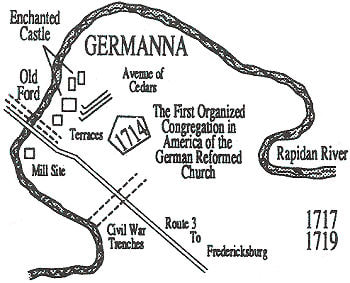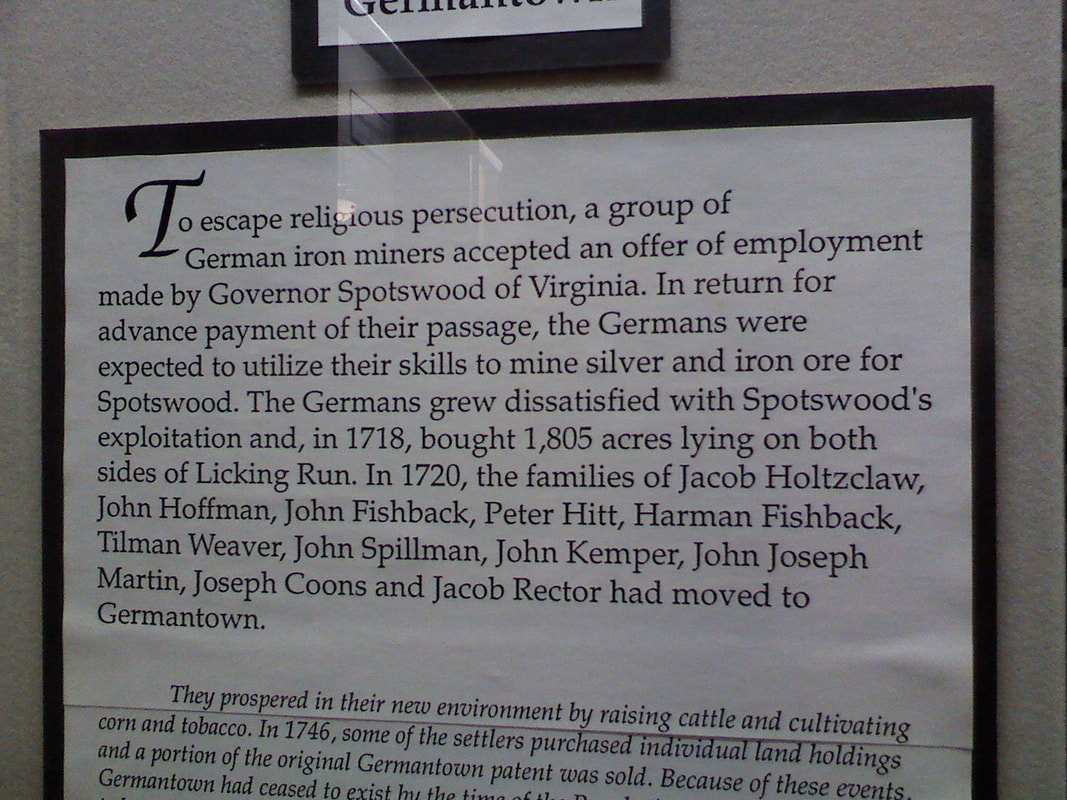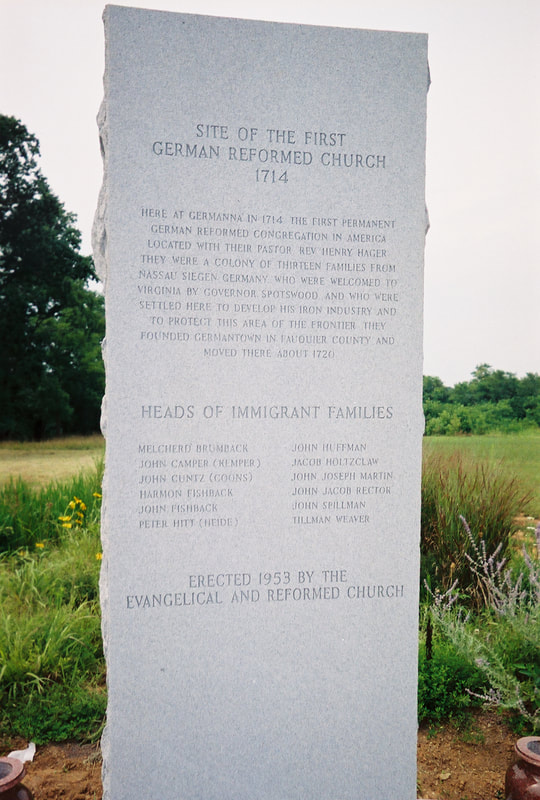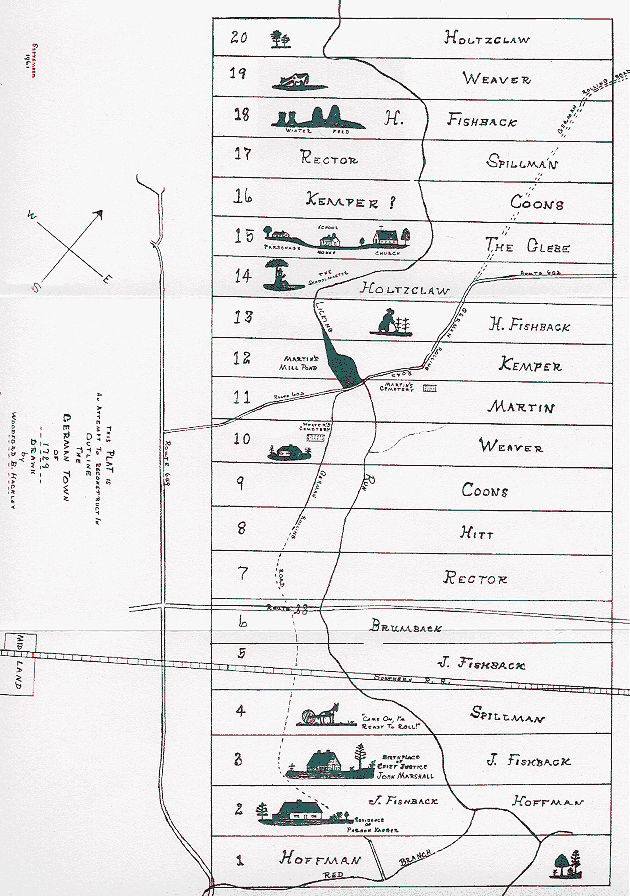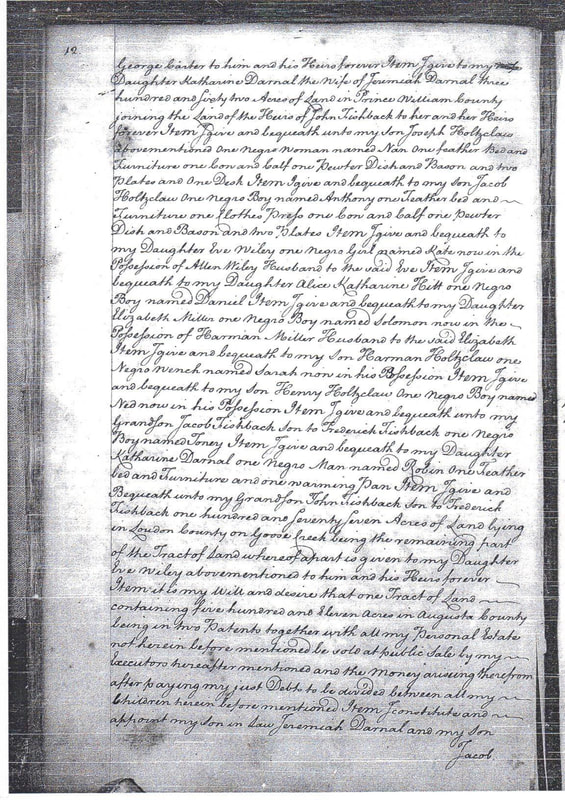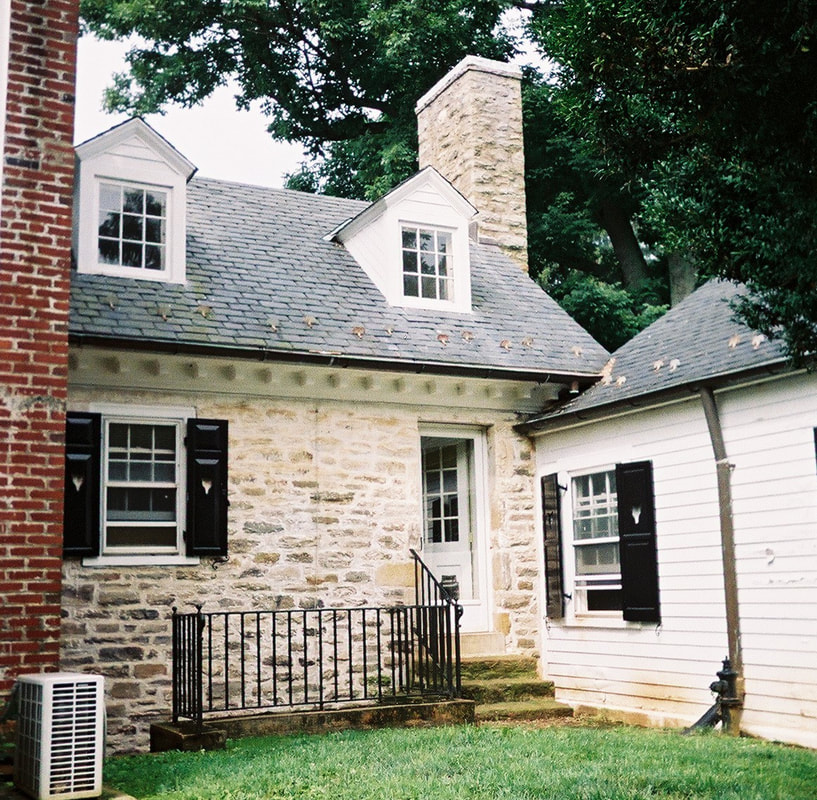Hans Jacob Holtzclaw
(1683- Unk.)
Anna Margreth Otterbach
(1686 – bet. 1754-1759)
(1683- Unk.)
Anna Margreth Otterbach
(1686 – bet. 1754-1759)
The Holtzclaw family immigrated to the United States from the principality of Nassau-Siegen, Germany in April 1714. Hans Jacob, known as Jacob, was the first generation of Holtzclaw's in America. He was born in 1683 in Truppbach, Nassau-Siegen, Germany. Jacob was a schoolmaster as was his father and older brother. He and his family went to German Reformed - St. Nicolai Evangelical Reformed Church at Siegen, Germany. Jacob died in 1760.
Jacob married Anna Margreth Otterbach on August 07, 1708 in Siegen, Germany. She was the daughter of Hermann Otterbach and Elizabeth Heimbach. Anna was born in 1686 in Truppbach, Nassau-Siegen, Germany and was christened in 1686 on the 9th Sunday after Trinity, St. Nicolai Reformed Church. She died Bet. 1754 – 1759.
Jacob immigrated to Viriginia in April, 1714 with eleven other families who were also relatives. They first settled at Germanna, Orange County, Virginia. In Virginia, Jacob held the position of "Reader" in the German Reformed Church. For this he received 30 pounds of tobacco annually from each family. In 1748, Reverand Matthew G. Gottschalk, a missionary, spoke of Jacob as "getting old" and "quite religious". Another missionary stated that "he [had] lodged with an old friend by the name of Holzklau. The little village is settled with Reformed miners from Nassau-Siegen. They live very quietly together and are nice people" – Excerpts from "The Genealogy of the Holtzclaw Family 1540-1935" by B. C. Holtzclaw, Ph.D.
Hans Jacob Holtzclaw was naturalized July 11, 1722, and the copy of his naturalization has been preserved in the records of Spotsylvania County, Deed Book A, page 165.
Jacob and Anna’s Children:
The following story was written by another Holtzclaw researcher:
Hans Jacob Holtzclaw and Anna Margreth Otterbach
Hans Jacob Holtzclaw, was born in Truppbach, Germany, in 1683, the son of Hans Henrich Holtzclaw and his wife, Gertrut Solbach. He was christened at St. Nicolai Church in Siegen, Germany on Laetare Sunday, 1683. Jacob grew up in Truppbach with his ten brothers and sisters. His parents had moved there in about 1680, when his father, Hans, took the position of Schoolmaster. It is probable that Jacob attended the famous Latin School in Siegen.
Jacob's brother, Johann served as schoolmaster at Oberfischbach, a nearby village. In 1707, Johann, who was only thirty-eight years old, died. Immediately after the death of his brother, Hans seems to have been asked to take the position of Schoolmaster in Oberfischbach left vacant by his brother's death. He was then twenty-four years of age. No doubt the acceptance of this new position enabled him to marry the following summer. On the 5th Sunday after Trinity, August 7, 1708, Hans Jacob Holtzclaw, schoolmaster at Oberfischbach, married Anna Margreth, daughter of Hermann Otterbach of Truppbach and his wife, Elizabeth (Heimbach) Otterbach. Anna Margreth was born at Truppbach in 1686, being christened at St. Nicolai Reformed Church in Siegen on the 9th Sunday after Trinity, 1686. For five years after his marriage, Jacob Holtzclaw lived quietly at Oberfischbach, carrying on his work as schoolmaster. There, too, were born his eldest children, both sons. The eldest and our ancestor, Johann (John) was born in 1709. In the year 1710, Alexander Spotswood became the Governor of Virginia. Having discovered evidence of iron ore in the direction of the Blue Ridge Mountains, he began immediately suggesting in letters to Queen Anne and to the Council of Trade in England that they should open iron mines in Virginia. A friend of Governor Spotswood was the Baron Christopher de Graffenried. de Graffenried had already begun negotiating with a John Justus Albrecht to bring workers for the mine from the neighborhood of Siegen. Albrecht seems to have exceeded his authority in getting his workers. When de Graffenried went to England in the summer of 1713, he was dumbfounded to find Albrecht and 40 people already in London. They had used up practically all their money in getting to London, but Spotswood and de Graffenried were not ready for them and advised them to return home. This they absolutely refused to do, saying that if necessary, they would sell themselves for four years as indented servants in order to pay their passage, rather than go back. de Graffenried and Spotswood managed to get them some work to do in England during the autumn of 1713. They lumped together all the money that they possessed in order to help pay their passage, de Graffenried got two London merchants to advance the balance of the passage money, on condition that they would be repaid by Spotswood when the colony reached Williamsburg, and in the beginning of the year 1714 they set sail for Virginia. They landed in Virginia in April of 1714. Spotswood on July 12, 1714, wrote to the Lords Commissioners of Trade in London: "In order to guard the frontiers from the Indians, I have placed here a number of Protestant Germans, built them a fort and furnished them with two pieces of cannon and some ammunition." It was the policy of the Virginia Government to place foreigners on the frontier to protect the English against the Indians. The new colony was called Germanna, and was situated in Orange County, on a remarkable horseshoe shaped peninsula containing about 400 acres with the Rapidan River surrounding it on the north, west and east. Our ancestors set up the first iron furnace in America, manufactured the first pig-iron, and established the first German Reformed Church on the continent. The colony worked for the Governor for over two and a half years, and no doubt by that time they had fully repaid what they owed him.They were granted land further to the north and west, in Stafford County, Virginia, and founded the settlement of Germantown. The original grant was made to only three members of the colony, John Henry Hoffman, John Fishback and Jacob Holtzclaw because only these three men had been naturalized. (Hans Jacob Holtzclaw was naturalized July 11, 1722, and the copy of his naturalization has been preserved in the records of Spotsylvania County, Deed Book A, page 165.) The actual legal transfer from the three to the remainder was not made till August 1729. Jacob Holtzclaw on his death left over 3,000 acres to his children, giving over 200 acres to each one male and female, and some to his grandchildren. The center of the colony was the church (German Reformed) and after the death of the pastor, Henry Haeger in 1737, our ancestor, Jacob Holtzclaw, was employed as "Reader." For this he received annually from each family thirty pounds of tobacco. Jacob always acted as schoolmaster in both Germanna and Germantown. Harman Utterback (Hermann Otterbach), father of our ancestress, Anna Margaret (Otterbach) Holtzclaw, who with his children and second wife, Anna Catherine (Hitt) Holtzclaw, also came to Virginia at an early date and settled near the colony. These people who had immigrated to the New World were not ordinary people. Our ancestor, Jacob Holtzclaw, had never been anything but a schoolmaster, and Henry Haeger, was both a teacher and a minister. They all worked in setting up the iron furnace at Germanna. However, they were by no means mere laborers. Rev. James Kemper, in the Kemper Genealogy states that they were "mostly mechanics and master workmen in their several trades." They had been prosperous middle-class citizens in Germany. All our colonists could read and write, and were thus far ahead of a vast number of Virginians of their day. One of their first cares after building a church, was to set up a school. Rev. Kemper said of our ancestor that he was a "good scholar." Jacob Holtzclaw's wife, Anna Margaret, seems to have been still living in 1729 when the Germantown land was distributed to the various families legally. She seems to have died soon after that, and Jacob married again. His second wife was named Catherine, though there is no evidence of her maiden name. Jacob and Catherine had three known children. She probably predeceased him, as there is no mention of her in Jacob Holtzclaw's will. Jacob Holtzclaw died early in the year 1760, aged 77 years. His second wife, Catherine, had died between 1754 and 1759) the date of writing his will). His will, dated January 15, 1759, was probated in Fauquier County, Virginia, February 29, 1760. Hans Jacob Holtzclaw b: 1683 d: 1760 . +Anna Margarethe Utterback b: June 1686 d: 1724-1729 John (Johann) Holzclaw b: Abt 1709 d: Abt 1750 .... +Catherine (Russell) Thomas b: Abt 1711 d: Aft 1763 Henry (Johann Heinrich) Holtzclaw b: November 14, 1711 d: 1778 .... +Nancy Hardin Katherine Holtzclaw b: 1715-1725 d: Abt 1810 .... +Jerimiah Darnall Ann Elizabeth Holtzclaw b: 1715-1725 d: Abt 1750 .... +John Frederick Fishbach Harmon Holtzclaw b: 1725-1729 d: 1762 .... +Elizabeth Alice Katherine Holtzclaw b: 1725-1729 .... +Henry Hitt b: Abt 1719 Elizabeth Holtzclaw b: 1725-1729 .... +Harman Miller *2nd Wife of Hans Jacob Holtzclaw: . +Catherine d: 1754-1759 Joseph (Jacob) Holtzclaw b: 1735-1740 d: Abt 1832 .... +Elizabeth Zimmerman*2nd Wife of Joseph (Jacob) Holtzclaw: .... +Mary Thomas Jacob Holtzclaw b: February 17, 1738 d: October 21, 1812 .... +Susanah Thomas Eve Holtzclaw b: 1735-1740 d: Aft 1812 .... +Allen Wiley
Jacob married Anna Margreth Otterbach on August 07, 1708 in Siegen, Germany. She was the daughter of Hermann Otterbach and Elizabeth Heimbach. Anna was born in 1686 in Truppbach, Nassau-Siegen, Germany and was christened in 1686 on the 9th Sunday after Trinity, St. Nicolai Reformed Church. She died Bet. 1754 – 1759.
Jacob immigrated to Viriginia in April, 1714 with eleven other families who were also relatives. They first settled at Germanna, Orange County, Virginia. In Virginia, Jacob held the position of "Reader" in the German Reformed Church. For this he received 30 pounds of tobacco annually from each family. In 1748, Reverand Matthew G. Gottschalk, a missionary, spoke of Jacob as "getting old" and "quite religious". Another missionary stated that "he [had] lodged with an old friend by the name of Holzklau. The little village is settled with Reformed miners from Nassau-Siegen. They live very quietly together and are nice people" – Excerpts from "The Genealogy of the Holtzclaw Family 1540-1935" by B. C. Holtzclaw, Ph.D.
Hans Jacob Holtzclaw was naturalized July 11, 1722, and the copy of his naturalization has been preserved in the records of Spotsylvania County, Deed Book A, page 165.
Jacob and Anna’s Children:
- Johann Holtzclaw, b. 1709
- Johann Heinrich Holtzclaw, b. November 14, 1711
- Ann Elizabeth Holtzclaw, b. Bet. 1715 – 1725
- Katherine Holtzclaw, b. Bet. 1715 – 1725
- Harman Holtzclaw, b. Bet. 1725 – 1730
- Elizabeth Holtzclaw, b. Bet. 1725 – 1730
- Alice Katherine Holtzclaw, b. Bet. 1725 – 1730
The following story was written by another Holtzclaw researcher:
Hans Jacob Holtzclaw and Anna Margreth Otterbach
Hans Jacob Holtzclaw, was born in Truppbach, Germany, in 1683, the son of Hans Henrich Holtzclaw and his wife, Gertrut Solbach. He was christened at St. Nicolai Church in Siegen, Germany on Laetare Sunday, 1683. Jacob grew up in Truppbach with his ten brothers and sisters. His parents had moved there in about 1680, when his father, Hans, took the position of Schoolmaster. It is probable that Jacob attended the famous Latin School in Siegen.
Jacob's brother, Johann served as schoolmaster at Oberfischbach, a nearby village. In 1707, Johann, who was only thirty-eight years old, died. Immediately after the death of his brother, Hans seems to have been asked to take the position of Schoolmaster in Oberfischbach left vacant by his brother's death. He was then twenty-four years of age. No doubt the acceptance of this new position enabled him to marry the following summer. On the 5th Sunday after Trinity, August 7, 1708, Hans Jacob Holtzclaw, schoolmaster at Oberfischbach, married Anna Margreth, daughter of Hermann Otterbach of Truppbach and his wife, Elizabeth (Heimbach) Otterbach. Anna Margreth was born at Truppbach in 1686, being christened at St. Nicolai Reformed Church in Siegen on the 9th Sunday after Trinity, 1686. For five years after his marriage, Jacob Holtzclaw lived quietly at Oberfischbach, carrying on his work as schoolmaster. There, too, were born his eldest children, both sons. The eldest and our ancestor, Johann (John) was born in 1709. In the year 1710, Alexander Spotswood became the Governor of Virginia. Having discovered evidence of iron ore in the direction of the Blue Ridge Mountains, he began immediately suggesting in letters to Queen Anne and to the Council of Trade in England that they should open iron mines in Virginia. A friend of Governor Spotswood was the Baron Christopher de Graffenried. de Graffenried had already begun negotiating with a John Justus Albrecht to bring workers for the mine from the neighborhood of Siegen. Albrecht seems to have exceeded his authority in getting his workers. When de Graffenried went to England in the summer of 1713, he was dumbfounded to find Albrecht and 40 people already in London. They had used up practically all their money in getting to London, but Spotswood and de Graffenried were not ready for them and advised them to return home. This they absolutely refused to do, saying that if necessary, they would sell themselves for four years as indented servants in order to pay their passage, rather than go back. de Graffenried and Spotswood managed to get them some work to do in England during the autumn of 1713. They lumped together all the money that they possessed in order to help pay their passage, de Graffenried got two London merchants to advance the balance of the passage money, on condition that they would be repaid by Spotswood when the colony reached Williamsburg, and in the beginning of the year 1714 they set sail for Virginia. They landed in Virginia in April of 1714. Spotswood on July 12, 1714, wrote to the Lords Commissioners of Trade in London: "In order to guard the frontiers from the Indians, I have placed here a number of Protestant Germans, built them a fort and furnished them with two pieces of cannon and some ammunition." It was the policy of the Virginia Government to place foreigners on the frontier to protect the English against the Indians. The new colony was called Germanna, and was situated in Orange County, on a remarkable horseshoe shaped peninsula containing about 400 acres with the Rapidan River surrounding it on the north, west and east. Our ancestors set up the first iron furnace in America, manufactured the first pig-iron, and established the first German Reformed Church on the continent. The colony worked for the Governor for over two and a half years, and no doubt by that time they had fully repaid what they owed him.They were granted land further to the north and west, in Stafford County, Virginia, and founded the settlement of Germantown. The original grant was made to only three members of the colony, John Henry Hoffman, John Fishback and Jacob Holtzclaw because only these three men had been naturalized. (Hans Jacob Holtzclaw was naturalized July 11, 1722, and the copy of his naturalization has been preserved in the records of Spotsylvania County, Deed Book A, page 165.) The actual legal transfer from the three to the remainder was not made till August 1729. Jacob Holtzclaw on his death left over 3,000 acres to his children, giving over 200 acres to each one male and female, and some to his grandchildren. The center of the colony was the church (German Reformed) and after the death of the pastor, Henry Haeger in 1737, our ancestor, Jacob Holtzclaw, was employed as "Reader." For this he received annually from each family thirty pounds of tobacco. Jacob always acted as schoolmaster in both Germanna and Germantown. Harman Utterback (Hermann Otterbach), father of our ancestress, Anna Margaret (Otterbach) Holtzclaw, who with his children and second wife, Anna Catherine (Hitt) Holtzclaw, also came to Virginia at an early date and settled near the colony. These people who had immigrated to the New World were not ordinary people. Our ancestor, Jacob Holtzclaw, had never been anything but a schoolmaster, and Henry Haeger, was both a teacher and a minister. They all worked in setting up the iron furnace at Germanna. However, they were by no means mere laborers. Rev. James Kemper, in the Kemper Genealogy states that they were "mostly mechanics and master workmen in their several trades." They had been prosperous middle-class citizens in Germany. All our colonists could read and write, and were thus far ahead of a vast number of Virginians of their day. One of their first cares after building a church, was to set up a school. Rev. Kemper said of our ancestor that he was a "good scholar." Jacob Holtzclaw's wife, Anna Margaret, seems to have been still living in 1729 when the Germantown land was distributed to the various families legally. She seems to have died soon after that, and Jacob married again. His second wife was named Catherine, though there is no evidence of her maiden name. Jacob and Catherine had three known children. She probably predeceased him, as there is no mention of her in Jacob Holtzclaw's will. Jacob Holtzclaw died early in the year 1760, aged 77 years. His second wife, Catherine, had died between 1754 and 1759) the date of writing his will). His will, dated January 15, 1759, was probated in Fauquier County, Virginia, February 29, 1760. Hans Jacob Holtzclaw b: 1683 d: 1760 . +Anna Margarethe Utterback b: June 1686 d: 1724-1729 John (Johann) Holzclaw b: Abt 1709 d: Abt 1750 .... +Catherine (Russell) Thomas b: Abt 1711 d: Aft 1763 Henry (Johann Heinrich) Holtzclaw b: November 14, 1711 d: 1778 .... +Nancy Hardin Katherine Holtzclaw b: 1715-1725 d: Abt 1810 .... +Jerimiah Darnall Ann Elizabeth Holtzclaw b: 1715-1725 d: Abt 1750 .... +John Frederick Fishbach Harmon Holtzclaw b: 1725-1729 d: 1762 .... +Elizabeth Alice Katherine Holtzclaw b: 1725-1729 .... +Henry Hitt b: Abt 1719 Elizabeth Holtzclaw b: 1725-1729 .... +Harman Miller *2nd Wife of Hans Jacob Holtzclaw: . +Catherine d: 1754-1759 Joseph (Jacob) Holtzclaw b: 1735-1740 d: Abt 1832 .... +Elizabeth Zimmerman*2nd Wife of Joseph (Jacob) Holtzclaw: .... +Mary Thomas Jacob Holtzclaw b: February 17, 1738 d: October 21, 1812 .... +Susanah Thomas Eve Holtzclaw b: 1735-1740 d: Aft 1812 .... +Allen Wiley
Links to articles regarding Jacob Holtzclaw:
The Wives of Jacob Holtzclaw
JANUARY 12, 2017 BY GERMANNA
By Barbara Price
The Family of Anna Margreth Otterbach
JANUARY 25, 2017 BY GERMANNA1 COMMENT
By Barbara Price
The Wives of Jacob Holtzclaw
JANUARY 12, 2017 BY GERMANNA
By Barbara Price
The Family of Anna Margreth Otterbach
JANUARY 25, 2017 BY GERMANNA1 COMMENT
By Barbara Price
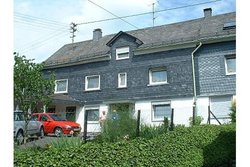
This the Jung/Holtzclaw home located in Trupbach, Germany. The Jung family lived on the left side of the house and the Holtzclaw family lived on the right side. The house was built around 1650 and is the birthplace of Hans Jacob Holtzclaw in 1683. The Jung family descendants still live here! Here is some information about the home of Hans Jacob Holzklau, located in Trupbach, Germany. He was born here in 1683, the name of the house is "Kromme," and it's located just a few hundred yards from his wife's house, "Welmes." His first wife, Anna Margreth Otterbach, was also born in Trupbach in 1685. I've traveled to Germany with the Germanna Foundation 4 times, and I'm going again this year. We visit Trupbach every time as many of the First Colony are from this village, i.e. Richter/Rector, Fischbach/Fishback, Heimbach/Hanback and Otterbach/Utterback This photo was taken in 2003, Barb Gregory Price in Trupbach Germany with the Germanna Foundation, located in Virginia.
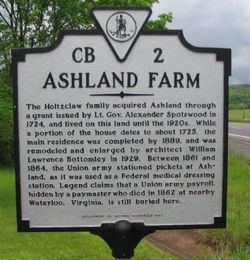
Erected 1992 by Department of Historic Resources. (Marker Number CB 2.)
Location. 38° 42.212′ N, 77° 52.396′ W. Marker is near Warrenton, Virginia, in Fauquier County. Marker is at the intersection of Lee Highway (U.S. 211) and Holtzclaw Road (Route 681), on the right when traveling east on Lee Highway. Marker is in this post office area: Warrenton VA 20186, United States of America.
Other nearby markers. At least 8 other markers are within 5 miles of this marker, as the crow flies. Second Manassas Campaign (a few steps from this marker); Stuart's Ride Around Pope (approx. 1.9 miles away); a different marker also named Second Manassas Campaign (approx. 2 miles away); Campaign of Second Manassas (approx. 3 miles away); Leeton Forest (approx. 3.6 miles away); Warrenton (approx. 3.7 miles away); Black Horse Cavalry (approx. 3.7 miles away); John Singleton Mosby (approx. 4.2 miles away). Click for a list of all markers in Warrenton.
Location. 38° 42.212′ N, 77° 52.396′ W. Marker is near Warrenton, Virginia, in Fauquier County. Marker is at the intersection of Lee Highway (U.S. 211) and Holtzclaw Road (Route 681), on the right when traveling east on Lee Highway. Marker is in this post office area: Warrenton VA 20186, United States of America.
Other nearby markers. At least 8 other markers are within 5 miles of this marker, as the crow flies. Second Manassas Campaign (a few steps from this marker); Stuart's Ride Around Pope (approx. 1.9 miles away); a different marker also named Second Manassas Campaign (approx. 2 miles away); Campaign of Second Manassas (approx. 3 miles away); Leeton Forest (approx. 3.6 miles away); Warrenton (approx. 3.7 miles away); Black Horse Cavalry (approx. 3.7 miles away); John Singleton Mosby (approx. 4.2 miles away). Click for a list of all markers in Warrenton.
Proudly powered by Weebly
